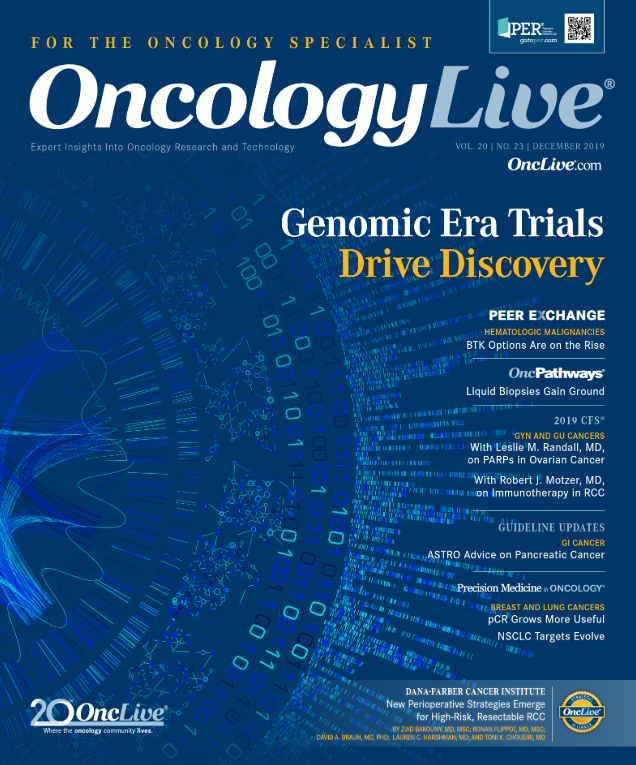ASTRO Presents First Guideline for RT in Pancreatic Cancer
Recent strides in systemic treatment approaches and the broader application of stereotactic radiation led the American Society for Radiation Oncology to issue its first guideline regarding radiation therapy in patients with pancreatic cancer.
Albert C. Koong, MD, PhD, cochair of the RT task force and chair of the Department of Radiation Oncology at The University of Texas MD Anderson Cancer Center

Albert C. Koong, MD, PhD
Recent strides in systemic treatment approaches and the broader application of stereotactic radiation led the American Society for Radiation Oncology (ASTRO) to issue its first guideline regarding radiation therapy (RT) in patients with pancreatic cancer, a setting in which appropriate use of RT has been largely undefined.1
“‘When should I radiate a patient with pancreatic cancer?’ is one of the questions I’m most commonly asked,” said Albert C. Koong, MD, PhD, cochair of the RT task force and chair of the Department of Radiation Oncology at The University of Texas MD Anderson Cancer Center in Houston.
The ASTRO guideline provides recommendations for optimal sequencing, dosing, and fractionation for RT as an adjuvant, neoadjuvant, and definitive therapy.1 It covers motion management, daily image guidance, use of contrast, and treatment with modulated techniques. Also, the task force supported prophylactic antiemetic medication and agents to reduce acid secretion. Manisha Palta, MD, a task force cochair, said the guideline’s focus on the use of RT across settings addresses “the black box that has surrounded its role” in pancreatic cancer.
Notably, the recommendations include the first clinical guidance on stereotactic body radiation (SBRT), a newer modality that has been found to provide promising local control with acceptable rates of toxicity and is more frequently used and investigated for patients with locally advanced and borderline resectable disease. “One thing this guideline offers that hasn’t been available previously is context about the current status of ablative RT such as SBRT and where it might be useful for patients with pancreatic cancer,” said Palta, an associate professor of radiation oncology at Duke Cancer Institute in Durham, North Carolina.2
The guideline authors make clear that, following a long period of few advances, RT’s role in pancreatic cancer is now evolving rapidly, with many areas of active investigation. Further, prospective studies just getting under way in the use of SBRT could alter the task force’s recommendations, they said (Table11,3).
Recommendations were rated according to their strength, the quality of evidence, and task force consensus. On key issues, many recommendations were “strong,” meaning benefits outweighed risks and the guidance was based on moderate or high levels of evidence. The task force was more diffident toward indications for conventional fractionated RT or SBRT, issuing multiple conditional recommendations (that is, benefits were finely balanced with risks), based on low-quality evidence, although consensus was high in many cases.
Table 1. Key Trial Data Awaited in Pancreatic Cancer1,3
Indications for Conventionally Fractionated RT or SBRT
Koong and Palta agreed that outmoded and conflicting clinical trial data contribute to the lack of clarity surrounding RT. “Many of the trials that have focused on the question of RT versus no RT are pretty antiquated in terms of technique,” Palta said. “Since the trials that were done in the 1970s and 1980s, there really hasn’t been a trial that has evaluated RT in pancreatic cancer.”
The majority of panelists (92%) supported adjuvant conventionally fractionated RT with chemotherapy following surgical resection of pancreatic cancer in select high-risk patients, although their recommendation was conditional.1 High-risk clinical features include positive lymph nodes and margins regardless of tumor location within the pancreas, authors said.
The panelists unanimously agreed that use of adjuvant SBRT should be limited to a clinical trial or multi-institutional registry after resection. Their recommendation was identified as strong, but they noted that the quality of supporting evidence was “very low,” highlighting the need for further investigation of adjuvant SBRT.
“The role of more ablative doses of radiation—SBRT, in particular—is an important area of clinical inquiry in pancreatic cancer,” Palta said. She added that she expects SBRT to become a more active area of investigation as more data on RT’s place in this disease setting become available.
The task force broadly supported (92%) neoadjuvant therapy for patients with resectable disease, but they were in less agreement on what a regimen should consist of for borderline cases and certain locally advanced pancreatic cancer appropriate for presurgical downstaging.1 Systemic chemotherapy followed by conventionally fractionated RT with chemotherapy was conditionally favored by 85% of the panel, and 77% conditionally recommended systemic chemotherapy followed by multifraction SBRT.
For patients with locally advanced disease that is not appropriate for downstaging to eventual surgery, 85% of the task force advocated for use of a definitive regimen of systemic chemotherapy followed by 1 of 3 options: conventionally fractionated RT with chemotherapy, dose-escalated chemoradiation, or multifraction SBRT without chemotherapy. The recommendation was conditional and the evidence quality was low.
The task force also offered recommendations for dose fractionation and target volumes (Table 21).
Regarding the sequencing of chemotherapy and RT, 92% of the panel strongly supported chemoradiation delivery after 4 to 6 months of systemic chemotherapy in patients with resected pancreatic cancer receiving adjuvant chemotherapy. This was based on moderate evidence.
Table 2. ASTRO Recommendations for RT and Chemotherapy Dose Fractionation1
Clinical Dissonance
RT was strongly recommended (92%) after 2 to 6 months of systemic chemotherapy for patients with borderline resectable disease receiving neoadjuvant therapy.1 The panel also largely (85%) supported the use of definitive RT in patients with unresectable or locally advanced disease without signs of systemic progression following ≥4 months of chemotherapy. Moderate-level evidence supported the latter 2 recommendations.
Discord between study findings has obscured the role of RT in pancreatic cancer. “Historically, data from the United States demonstrated a survival benefit with adjuvant chemoradiation following resection, but findings from larger, more recent trials in Europe demonstrated that there was no advantage,” Koong said.
In pancreatic cancer, optimal use of RT has been most unclear in the adjuvant setting, according to Palta. Broadly, oncologists in the field, including Palta, are eagerly awaiting results from the ongoing phase III Radiation Therapy Oncology Group (RTOG) 0848 study (NCT01013649) of adjuvant chemoradiation in patients with pancreatic cancer that has been surgically removed, which will shed light on the adjuvant use of RT. “That trial is likely to have some information in the coming year or so, but right now we’re at a bit of a crossroads where there aren’t a lot of data to guide how and when we should give radiation, at least in the adjuvant setting,” Palta said.
Recently published findings from the Unicancer GI PRODIGE 24/CCTGPA.6 trial (NCT01526135) are also “likely to alter the adjuvant therapy landscape,” the guideline states.1 Further, these data are expected to influence the interpretation of results from RTOG 0840 because both trials involve a chemotherapeutic intervention.
ASTRO’s guideline is based only on findings in the field published during the task force’s literary review period, which spanned May 1, 2007, to June 5, 2017. However, a forward-looking assessment of coming clinical trial data and their implications reflects the notion that pancreatic cancer treatment is in a state of f lux. “This is a rapidly evolving field,” Palta said in a statement. “Some potentially practice-changing studies that are not included in this guideline may become available in the relatively near-term future.”2
With the rise of new survival extending systemic therapies, RT will become an increasingly important means of local disease control in pancreatic cancer, Koong and Palta predicted.
“Achieving local control is critical when patients are living long enough to manifest symptoms related to local progression of their disease, such as pain and obstruction,” Koong said.
Standardizing Approach
ASTRO’s guideline also contains recommendations for simulation considerations, treatment planning, prophylactic medications to manage toxicity, and palliative RT.1 The patient-centric guideline supports multidisciplinary evaluation and engagement in decision making for all patients.
The breadth of the guideline makes it a useful resource for gastrointestinal specialists and general oncologists alike, Palta said, particularly because pancreatic cancer is “still relatively uncommon but very deadly.”
Pancreatic cancer is the 11th most common cancer diagnosed among adults in the United States and the third leading cause of cancer death. In 2019, there will be an estimated 56,770 new pancreatic cancer diagnoses; approximately 45,570 of these patients will die of complications of the disease.2
Historically, pancreatic cancer has been recognized as more aggressive than other cancers.2 It is associated with high rates of local and distant recurrence (50%-90%) and low survival rates; the 5-year relative survival rate is 9%. More than half of diagnoses are made after the cancer has metastasized, at which point the 5-year relative survival rate drops to 2.9%.
References
- Palta M, Godfrey D, Goodman KA, et al. Radiation therapy for pancreatic cancer: executive summary of an ASTRO clinical practice guideline. Pract Radiat Oncol. 2019;9(5):322-332. doi: 10.1016/j.prro.2019.06.016.
- New guideline clarifies role of radiation therapy in pancreatic cancer treatment [news release]. Arlington, VA: American Society for Radiation Oncology; September 4, 2019. www. astro.org/News-and-Publications/News-and-Media-Center/ News-Releases/2019/New-guideline-clarifies-role-of-radiation-therapy. Accessed November 5, 2019.
- Van Tienhoven G, Versteijne E, Suker M, et al. Preoperative chemoradiotherapy versus immediate surgery for resectable and borderline resectable pancreatic cancer (PREOPANC-1): a randomized, controlled, multicenter phase III trial. J Clin Oncol. 2018;36(suppl 18; abstrLBA4002). doi: 10.1200/JCO.2018.36.18_suppl.LBA4002.




